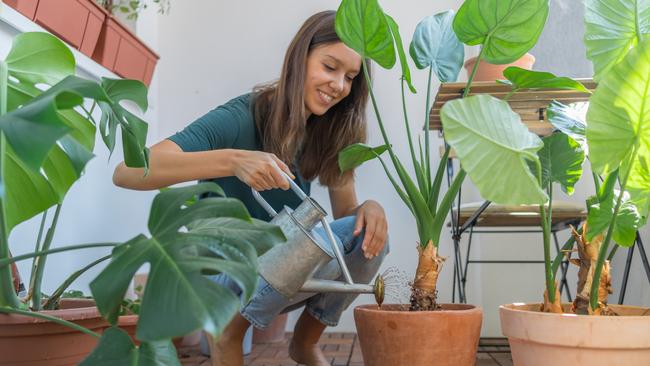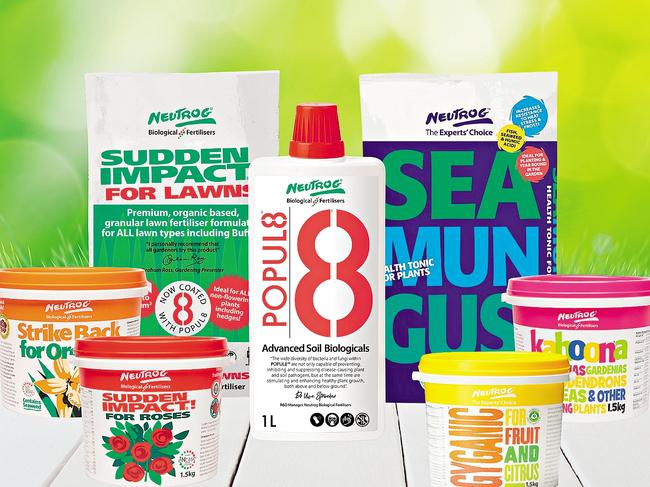It’s a myth that hot sun will cause water droplets to burn leaves
There’s a right way to water, and a wrong way. Here’s my quick guide.

You’d think it was one of the easiest jobs in the garden, but effective, efficient watering of plants is much more than just splashing some drops around. Water is critical to plants’ survival – it helps plants stand upright, runs their evaporative cooling system and carries dissolved nutrients. How often you need to water different plants depends on the type of plant, its maturity, the soil type or pot size, and of course, the weather.
High temperatures, direct sun, low humidity and wind all make plants dry out more quickly. Small pots heat up and dry out much faster than larger pots or garden beds. Young plants are less resilient than well-established ones, and sandy soils don’t hold water as well as enriched or clay soils.
Water needs to reach the roots in the soil, not the leaves. When hand watering, use a hose nozzle with a gentle shower spray so you don’t blast the soil. Allow time for water to penetrate – you might need to go along a row of plants and then do a second pass. The same applies for watering pots and newly planted plants whose rootballs are still only as big as the pot they came in. Hand-water new plantings at their bases for the first six to eight weeks or until the roots grow out into the surrounding soil. For established trees and large shrubs, fine roots that absorb water and nutrients are out around the “drip zone” or outer edge of the canopy – and beyond.
Deep root systems help plants survive drought; desert trees can have roots down to 10m, even up to 60m deep. You can encourage strong root systems by watering deeply with increasingly long intervals between drinks. Frequent, light watering promotes shallow roots that are vulnerable to drying out. The exceptions include most vegetables, which generally have high water needs and are short lived. It’s a good strategy to group plants with similar water needs together so they can get a watering regimen that suits them.
The best time to water is in the morning when evaporation rates are low and foliage can dry readily, minimising fungal diseases. This also gives roots essential moisture ahead of hot days when leaves are more likely to burn if the plants are water stressed. But if you missed that opportunity and your plants are wilting at midday, give them a good soak; it’s just a myth that hot sun will cause water droplets to burn leaves.
Potting mix and sandy soils can become water repellent, causing water to roll off the top rather than sinking in. For an instant fix, apply a liquid wetting agent such as Eco-hydrate or Wettasoil every few months. Granular SaturAid is easier to apply across larger garden beds and lasts up to 12 months. Mulching significantly reduces evaporative water losses from the soil. The finer the mulch particles, the thinner the layer needs to be so that rainfall can still get through to the soil.
For vegetables, annual and perennial flowers, fruit trees and roses, a soft mulch such as sugarcane mulch, lucerne or pea straw is best. These break down easily to feed the soil but need topping up frequently. In general garden beds, coarser, woody mulches such as pine bark and forest mulch do a great job and last much longer. Pebbles and gravels are ideal for succulents that drop few leaves and hate humidity.
Q&A
My row of lemon cypress (Cupressus macrocarpa ‘Wilma’), planted three years ago, have dead patches that are spreading, despite good care.
Robert Chessell, Melbourne
Cypress canker causes sudden death of branches, affecting most Cupressus species. There is no cure. The fungal spores are spread through wind, water, insects and pruning tools, entering through bark fissures or pruning wounds. Older and stressed trees are more susceptible, so keep yours healthy with regular feeding and watering; Seasol and microbial products such as POPUL8 may help. Removing infected branches might help limit the spread.
My two new peace lilies are potted in sphagnum moss. Are there nutrients in this? Should I re-pot?
Graham, Nerang, Qld
Usually just one component of potting mixes, sphagnum moss holds water like a sponge but on its own, shrinks when dry and can be hard to re-wet. It’s often acidic. As it decomposes, aeration becomes poor. It has no nutrient value, so liquid fertilise monthly. Re-potting into premium potting mix is safer and longer lasting. After the mix’s fertiliser is used up after a few months, start liquid fertilising.
What can I do about powdery mildew on zucchinis? Isn’t this an end-of-season disease?
Margaret White, mid-north coast NSW
While common when plants are weaker at the end of their life cycle, this fungal disease can attack when weather favours it. Act at the first signs – cut off affected leaves and spray plants weekly with one part full cream milk in nine parts water, or use Eco-fungicide. Water in the mornings so leaves dry quickly. Seaweed tonics improve resistance.

Send your questions to: helenyoungtwig@gmail.com or Helen Young, PO Box 3098, Willoughby North, NSW 2068. The best question for December/January wins $200 worth of Neutrog products including POPUL8, Kahoona, Gyganic and Seamungus.



